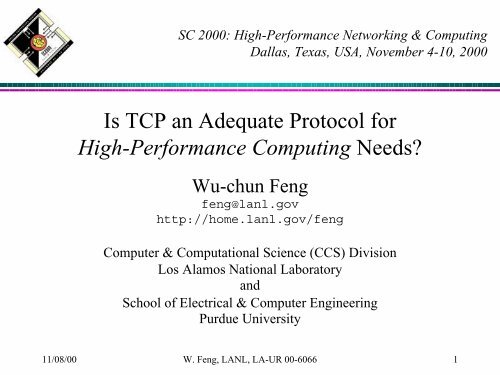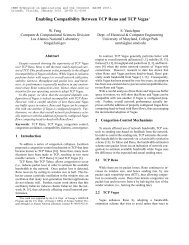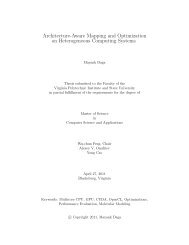Is TCP an adequate protocol for high-performance - Los Alamos ...
Is TCP an adequate protocol for high-performance - Los Alamos ...
Is TCP an adequate protocol for high-performance - Los Alamos ...
Create successful ePaper yourself
Turn your PDF publications into a flip-book with our unique Google optimized e-Paper software.
SC 2000: High-Per<strong>for</strong>m<strong>an</strong>ce Networking & Computing<br />
Dallas, Texas, USA, November 4-10, 2000<br />
<strong>Is</strong> <strong>TCP</strong> <strong>an</strong> Adequate Protocol <strong>for</strong><br />
High-Per<strong>for</strong>m<strong>an</strong>ce Computing Needs<br />
Wu-chun Feng<br />
feng@l<strong>an</strong>l.gov<br />
http://home.l<strong>an</strong>l.gov/feng<br />
Computer & Computational Science (CCS) Division<br />
<strong>Los</strong> <strong>Alamos</strong> National Laboratory<br />
<strong>an</strong>d<br />
School of Electrical & Computer Engineering<br />
Purdue University<br />
11/08/00 W. Feng, LANL, LA-UR 00-6066 1
Q & A<br />
Q: <strong>Is</strong> <strong>TCP</strong> <strong>an</strong> <strong>adequate</strong> <strong>protocol</strong> <strong>for</strong> <strong>high</strong>-per<strong>for</strong>m<strong>an</strong>ce<br />
computing (HPC) needs<br />
A: No!<br />
Q: C<strong>an</strong> <strong>TCP</strong> be made into <strong>an</strong> <strong>adequate</strong> <strong>protocol</strong> <strong>for</strong> <strong>high</strong>per<strong>for</strong>m<strong>an</strong>ce<br />
computing needs<br />
A: Maybe.<br />
Q: What is the networking environment <strong>for</strong> HPC<br />
A: System-area network (or LAN) <strong>for</strong> cluster computing.<br />
Wide-area network <strong>for</strong> computational grid.<br />
11/08/00 W. Feng, LANL, LA-UR 00-6066 2
What’s Wrong with <strong>TCP</strong><br />
• Host-Interface Bottleneck<br />
– Software<br />
• A host c<strong>an</strong> only send <strong>an</strong>d receive packets as fast as the OS c<strong>an</strong><br />
process the packets.<br />
– [ Hardware (PC) Not <strong>an</strong>ything wrong with <strong>TCP</strong> per se.<br />
• PCI I/O bus. 64 bit, 66 MHz = 4.2 Gb/s. Solution: InfiniB<strong>an</strong>d ]<br />
• Adaptation Bottlenecks<br />
– Flow Control<br />
• No adaptation currently being done in <strong>an</strong>y st<strong>an</strong>dard <strong>TCP</strong>.<br />
• Static-sized window/buffer is supposed to work <strong>for</strong> both the<br />
LAN <strong>an</strong>d WAN.<br />
– Congestion Control<br />
• Adaptation mech<strong>an</strong>isms will not scale, particularly <strong>TCP</strong> Reno.<br />
11/08/00 W. Feng, LANL, LA-UR 00-6066 3
Host-Interface Bottleneck (Software)<br />
• First-Order Approximation<br />
– deliverable b<strong>an</strong>dwidth = maximum-sized packet / interrupt latency<br />
– e.g., 1500-byte MTU / 50 µs = 30 MB/s = 240 Mb/s<br />
• Problems<br />
– Maximum-sized packet (or MTU) is only 1500 bytes <strong>for</strong> Ethernet.<br />
– Interrupt latency to process a packet is quite <strong>high</strong>.<br />
– CPU utilization <strong>for</strong> network tasks is too <strong>high</strong>.<br />
• Solutions (Non-<strong>TCP</strong>, Non-St<strong>an</strong>dard)<br />
– Reduce frequency of interrupts, e.g., interrupt coalescing or OS-bypass<br />
– Increase effective MTU size, e.g., interrupt coalescing or jumbograms.<br />
– Reduce interrupt latency, e.g., push checksums into hardware.<br />
– Reduce CPU utilization, e.g., offload <strong>protocol</strong> processing to NIC.<br />
11/08/00 W. Feng, LANL, LA-UR 00-6066 4
666-MHz Single CPU Alpha Linux<br />
Courtesy: USC/ISI<br />
CPU Utilization (%)<br />
120<br />
100<br />
80<br />
60<br />
40<br />
20<br />
0<br />
100 200 300 400 500 600 700 800 900<br />
Throughput (Mb/s)<br />
1500-byte MTU<br />
4000-byte MTU<br />
9000-byte MTU<br />
Note: The congestion-control mech<strong>an</strong>ism does not get activated in these tests.<br />
11/08/00 W. Feng, LANL, LA-UR 00-6066 5
Non-<strong>TCP</strong>, Non-St<strong>an</strong>dard Solutions<br />
• Interrupt Coalescing<br />
– Increases b<strong>an</strong>dwidth (BW) at the expense of even <strong>high</strong>er latency.<br />
• Jumbograms<br />
– Increases BW with minimal increase in latency, but at the expense of<br />
more blocking in switches/routers.<br />
• OS-Bypass Protocol<br />
– Increases BW & decreases latency by <strong>an</strong> order of magnitude or more.<br />
– Integrate OS-bypass into <strong>TCP</strong><br />
VIA over <strong>TCP</strong> (IETF Internet Draft, GigaNet, July 2000).<br />
• Interrupt Latency Reduction (possible remedy <strong>for</strong> <strong>TCP</strong>)<br />
– Provide “zero-copy” <strong>TCP</strong> (a la OS-bypass) but OS still middlem<strong>an</strong>.<br />
– Push <strong>protocol</strong> processing into hardware, e.g., checksums.<br />
11/08/00 W. Feng, LANL, LA-UR 00-6066 6
Benchmarks: <strong>TCP</strong><br />
• <strong>TCP</strong> over Gigabit Ethernet (via loopback interface)<br />
Problem<br />
Data copies<br />
across mem.<br />
bus. (Cong.<br />
ctrl.)<br />
– Theoretical Upper-Bound: 750 Mb/s due to the nature of <strong>TCP</strong> Reno.<br />
– Environment: Red Hat Linux 6.2 OS on 400-MHz & 733-MHz Intel PCs;<br />
Alteon AceNIC GigE cards; 32-bit, 33-MHz PCI bus.<br />
– Test: Latency & b<strong>an</strong>dwidth over loopback interface.<br />
• Latency: O(50 µs).<br />
Solution<br />
OS-bypass<br />
• Peak BW w/ default set-up: 335 Mb/s (400) & 420 Mb/s (733).<br />
• Peak BW w/ m<strong>an</strong>ual tweaks by network gurus at both ends: 625 Mb/s.<br />
– Ch<strong>an</strong>ge default send/receive buffer size from 64 KB to 512 KB.<br />
– Enable interrupt coalescing. (2 packets per interrupt.)<br />
– Jumbograms. Theor. BW: 18000 / 50 = 360 MB/s = 2880 Mb/s.<br />
– Problem: OS is the middlem<strong>an</strong>. Faster CPUs provide slightly less latency<br />
<strong>an</strong>d slightly more BW. 10GigE BW <strong>for</strong> a <strong>high</strong>-speed connection wasted.<br />
11/08/00 W. Feng, LANL, LA-UR 00-6066 7
OS-Bypass Protocol<br />
Host<br />
Bottleneck: Application-to-network interface.<br />
Appl.<br />
OS-Bypass<br />
OS<br />
<strong>TCP</strong>/IP<br />
NIC<br />
Network<br />
(e.g., HIPPI-6400)<br />
• Over the WAN How would it compare to HP-<strong>TCP</strong><br />
• Problems with OS-Bypass: Routing & congestion control.<br />
Hence, the proposal <strong>for</strong> VIA over <strong>TCP</strong>.<br />
11/08/00 W. Feng, LANL, LA-UR 00-6066 8
Benchmarks: OS-Bypass<br />
Two orders of magnitude faster wrt latency <strong>an</strong>d one wrt BW (when compared to <strong>TCP</strong>).<br />
• GM over Myrinet 2000 Interconnect<br />
– Peak B<strong>an</strong>dwidth: 2.0 Gb/s.<br />
– User-Level (Reference: Myrinet web site & brochure.)<br />
• Latency: 9 µs.<br />
• B<strong>an</strong>dwidth: 225 MB/s = 1.8 Gb/s.<br />
• El<strong>an</strong> OS-Bypass Library over Quadrics Interconnect<br />
– Peak B<strong>an</strong>dwidth: 3.2 Gb/s.<br />
– User-Level (Reference: Petrini, Hoisie, Feng, & Graham.)<br />
• Latency: 1.9 µs.<br />
• B<strong>an</strong>dwidth (unidirectional): 307 MB/s = 2.5 Gb/s.<br />
All is not rosy. Flow control but no congestion control. M<strong>an</strong>ually configured routing tables.<br />
11/08/00 W. Feng, LANL, LA-UR 00-6066 9
Adaptation Bottleneck<br />
• Flow Control<br />
– <strong>Is</strong>sues<br />
• No adaptation currently being done in <strong>an</strong>y st<strong>an</strong>dard <strong>TCP</strong>.<br />
• 32-KB static-sized window/buffer that is supposed to work <strong>for</strong><br />
both the LAN <strong>an</strong>d WAN.<br />
– Problem: Large b<strong>an</strong>dwidth-delay products require flow-control<br />
windows as large as 512-KB or 1024-KB to fill the network pipe.<br />
– Consequence: As little as 3% of network pipe is filled.<br />
– Solutions<br />
• M<strong>an</strong>ual tuning of buffers at send <strong>an</strong>d receive end-hosts.<br />
• Automatic tuning of buffers.<br />
– PSC: Auto-tuning but does not abide by <strong>TCP</strong> sem<strong>an</strong>tics, 1998.<br />
– LANL: Dynamic right-sizing, 2000.<br />
• Network striping & pipelining w/ default buffers. UIC, 2000.<br />
11/08/00 W. Feng, LANL, LA-UR 00-6066 10
Adaptation Bottlenecks<br />
• Congestion Control<br />
– Adaptation mech<strong>an</strong>isms will not scale due to<br />
• Additive increase / multiplicative decrease algorithm<br />
• <strong>TCP</strong> Reno congestion control<br />
– Bad: Allow/induce congestion.<br />
Detect & recover from congestion. (Synch prob.)<br />
Analogy: “Deadlock detection & recovery” in OS.<br />
– Result: At best, 75% utilization in steady state.<br />
• <strong>TCP</strong> Vegas congestion control<br />
– Better: Approach congestion but try to avoid it.<br />
Usually results in better network utilization.<br />
Analogy: “Deadlock avoid<strong>an</strong>ce” in OS.<br />
11/08/00 W. Feng, LANL, LA-UR 00-6066 11
“Optimal” B<strong>an</strong>dwidth<br />
• The future per<strong>for</strong>m<strong>an</strong>ce of computational grids looks bad if we continue to<br />
rely on the widely-deployed <strong>TCP</strong> Reno.<br />
Example: High BW-delay product: 1 Gb/s WAN * 100 ms RTT = 100 Mb<br />
• Additive increase<br />
– when window size is 1 100% increase in window size.<br />
– when window size is 1000 0.1% increase in window size.<br />
50 Mb available BW<br />
window<br />
size<br />
25 Mb<br />
Re-convergence to<br />
“optimal” b<strong>an</strong>dwidth<br />
takes over 3 minutes!<br />
11/08/00 W. Feng, LANL, LA-UR 00-6066 12
What’s Wrong with <strong>TCP</strong><br />
• Host-Interface Bottleneck<br />
– Software<br />
• A host c<strong>an</strong> only send <strong>an</strong>d receive packets as fast as the OS c<strong>an</strong><br />
BW problems potentially solvable. Latency<br />
process the packets. Based on past trends, the I/O bus will<br />
– Hardware (PC)<br />
continue to be a bottleneck.<br />
• PCI I/O bus. 64 bit, 66 MHz = 4.2 Gb/s. Solution: InfiniB<strong>an</strong>d<br />
• Adaptation Bottlenecks<br />
– Flow Control<br />
• No adaptation currently being done in <strong>an</strong>y st<strong>an</strong>dard <strong>TCP</strong>.<br />
• Static-sized window/buffer is supposed to work <strong>for</strong> both the<br />
Solutions exist but are not widely deployed.<br />
LAN <strong>an</strong>d WAN.<br />
– Congestion Control<br />
<strong>TCP</strong> Vegas <strong>for</strong> <strong>high</strong>-per<strong>for</strong>m<strong>an</strong>ce <strong>TCP</strong><br />
• Adaptation mech<strong>an</strong>isms will not scale, particularly <strong>TCP</strong> Reno.<br />
11/08/00 W. Feng, LANL, LA-UR 00-6066 13
That’s all folks!




